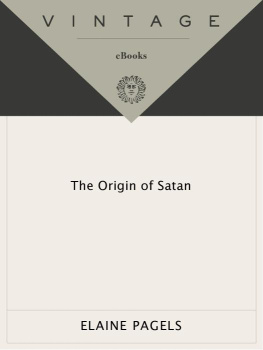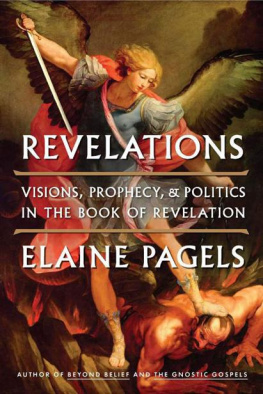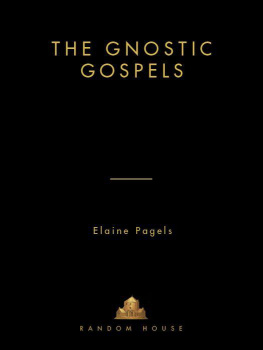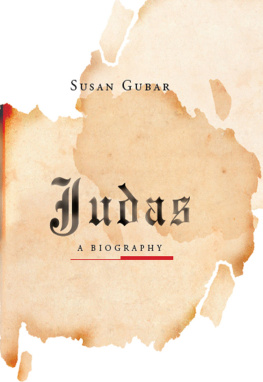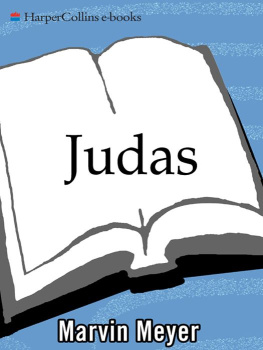The Gospel of Judas. Coptic Text . The National Geographic Society, April 2006 (published online at http://www.nationalgeographic.com/lostgospel/document.html), with modifications based on an advance copy of the critical edition of the Tchacos Codex edited by Rodolphe Kasser and Gregor Wurst; English translation by Marvin Meyer and F. Gaudard; notes by Marvin Meyer and Gregor Wurst, to be published by the National Geographic Society, Washington, D.C., spring 2007. We would like to thank Marvin Meyer for generously allowing us to see an advance copy of this edition. Any restorations proposed here, however, remain tentative until they can be confirmed by examination of the original manuscript of the announced facsimile edition.
ALSO BY ELAINE PAGELS
Beyond Belief: The Secret Gospel of Thomas
The Origin of Satan
Adam, Eve, and the Serpent
The Gnostic Gospels
The Gnostic Paul
ALSO BY KAREN L. KING
The Secret Revelation of John
What Is Gnosticism?
The Gospel of Mary of Magdala
Reading Judas
THE GOSPEL OF JUDAS AND
THE SHAPING OF CHRISTIANITY
Elaine Pagels and Karen L. King
VIKING
VIKING
Published by the Penguin Group
Penguin Group (USA) Inc., 375 Hudson Street,
New York, New York 10014, U.S.A.
Penguin Group (Canada), 90 Eglinton Avenue East, Suite 700,
Toronto, Ontario, Canada M4P 2Y3 (a division of Pearson Penguin Canada Inc.)
Penguin Books Ltd, 80 Strand, London WC2R 0RL, England
Penguin Ireland, 25 St. Stephen's Green, Dublin 2, Ireland (a division of Penguin Books Ltd)
Penguin Books Australia Ltd, 250 Camberwell Road, Camberwell,
Victoria 3124, Australia (a division of Pearson Australia Group Pty Ltd)
Penguin Books India Pvt Ltd, 11 Community Centre,
Panchsheel Park, New Delhi-110 017, India
Penguin Group (NZ), 67 Apollo Drive, Mairangi Bay, Auckland 1311,
New Zealand (a division of Pearson New Zealand Ltd.)
Penguin Books (South Africa) (Pty) Ltd, 24 Sturdee Avenue,
Rosebank, Johannesburg 2196, South Africa
Penguin Books Ltd, Registered Offices: 80 Strand, London WC2R 0RL, England
First published in 2007 by Viking Penguin, a member of Penguin Group (USA) Inc.
Copyright Elaine Pagels and Karen L. King, 2007
English Translation and Comments on the Translation copyright Karen L. King, 2007
All rights reserved
ISBN: 978-1-1012-0213-5
Without limiting the rights under copyright reserved above, no part of this publication may be reproduced, stored in or introduced into a retrieval system, or transmitted, in any form or by any means (electronic, mechanical, photocopying, recording or otherwise), without the prior written permission of both the copyright owner and the above publisher of this book.
The scanning, uploading, and distribution of this book via the Internet or via any other means without the permission of the publisher is illegal and punishable by law. Please purchase only authorized electronic editions and do not participate in or encourage electronic piracy of copyrightable materials. Your support of the author's rights is appreciated.
To Lyn and Norman Lear in loving friendship
E. P.
and
To Norman C. Cluley with warmest gratitude for his unfailing love and support
K. L. K.
Contents
Introduction
F OR MORE THAN A DECADE we had heard rumors that a fabled gospel ascribed to Judas Iscariot had been discovered. In April 2006, the archaeological find was at last made public by the National Geographic Society. We now know that sometime in the 1970s, a copy of the Gospel of Judas, translated into Coptic from its original second-century Greek, had been found in Middle Egypt near Al Minya. It is rumored that peasants accidentally came upon a burial cave containing a limestone box that for centuries had carefully preserved ancient writings. One of these was a papyrus book (the Tchacos Codex) that dates approximately to the fourth century. Over the years, dealers secretly showed these writings to a number of people in efforts to sell them at an extraordinary price. Moved from place to place and improperly storedfirst in a humid safety-deposit box in Hicksville, New York, for almost seventeen years, and later frozen (!)the Tchacos Codex suffered considerable damage from the time it was found until 2001, when it came into the able hands of the philologian Rodolphe Kasser, who, along with the conservator Florence Darbre and the historian Gregor Wurst, labored hard over the fragments for five years to restore the text as close as possible to its original condition. The new translation into English offered here is based on their work.
Our concern here, however, is not with the history of the discovery but with the meaning of this extraordinary find. Historians already knew about the Gospel of Judas from the writing Against Heresies by the second-century church father Irenaeus, who wrote about a group of Christians:
They declare that Judas the traitor was thoroughly acquainted with these things, and that he alone, knowing the truth as no others did, accomplished the mystery of the betrayal; by him all things, both earthly and heavenly, were thus thrown into confusion. They produced a fictitious history of this kind, which they style the Gospel of Judas.
The Gospel of Judas thus must have existed at the time Irenaeus wrote against it, around 180 C.E. The gospel itself was probably written in the midsecond centurybut Irenaeuss comments only provoke more questions. What did this mysterious gospel say beyond promoting Judas as the one who knew the truth as no others did? What truth did he know?
At our first reading, the author of the Gospel of Judas struck us as a very angry man with an offensive, even hateful, message, for he portrays Jesus repeatedly mocking his disciples and charging them with committing all kinds of sins and impurities in his name. And it seemed to us that the author was doing exactly that himselfusing Jesuss name to propagate his own homophobic and anti-Jewish views. We felt an immediate aversion to the Gospel s sometimes strident, mocking tone and slanderous accusations. It felt too much like the other side of the bitter invective so well known from the harangues of early church fathers like Irenaeus against their opponentsthe kind of polarizing language that is so deeply disturbing in our own era of religious and political discord and violence.
But once we moved past this initial impression, we found that not all is angry. Much of the Gospel of Judas is filled with Jesuss brilliant teaching about the spiritual life. Why, then, the authors rage? What matters so deeply? And most important, what hope does the author offer to redeem his anger? The answers to these questions lead deep into the agonizing controversies and exultant visions of God that would ultimately come to shape Christianity and capture the hearts and souls of people for millennia to come. These are the matters we address in Reading Judas: The Gospel of Judas and the Shaping of Christianity.
The most obvious questions are the easiest to answer: Did Judas really write this gospel? Can we learn anything new here about the historical Judas, Jesus, or his other disciples? Because the Gospel of Judas was written sometime around 150 C.E. , about a century after Judas would have lived, it is impossible that he wrote it; the real author remains anonymous. Neither do we learn anything historically reliable about Judas or Jesus beyond what we already know from other early Christian literature. Instead, the Gospel of Judas opens a window onto the disputes among second-century Christians over the meaning of Judass betrayal and Jesuss teaching, raising such questions as: Why would a troubled disciple betray his master, Jesus? How could any Christian imagine Judashis betrayerto be Jesuss favorite and most trusted disciple? Why condemn Jesuss other disciples as immoral killers? What are the mysteries of the kingdom that Jesus reveals to Judas alone? Why is it his star that leads the way?


